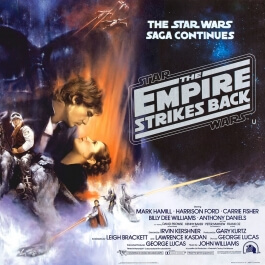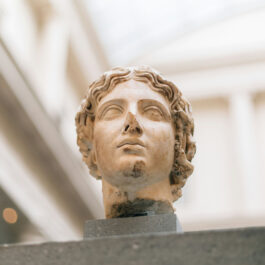Culture
What Happened Next? The Art Of The Ambiguous Movie Ending
Slide Nr 1As movie-goers, we’re used to films having neat endings with everything tied up before we finish our popcorn. However, some of the most famous movies of all time have left us with more questions than answers. Did the hero live? Was it all a dream? What was said at the end? Here are our favourites, alongside the best and worst theories as to what really happened… Warning: spoilers ahead!
0/16
Culture
What Happened Next? The Art Of The Ambiguous Movie Ending.
Slide Nr 2Blade Runner (1982) – Cinema’s most enduring debate: was Harrison Ford’s Richard Deckard a replicant? The case for each side depends on what edit of the film you watch, with the 1989 director’s cut including a dream sequence that first introduced the theory. Even the filmmakers disagreed: Ford said he was human, director Ridley Scott said replicant. The recent sequel, Blade Runner: 2049, offered little resolution, other than an older Deckard simply saying, “I know what’s real.” Whatever your stance, the ambiguity has become part of the film’s legacy, with the entire message of the film shifting depending on the particular theory.
1/16
Culture
What Happened Next? The Art Of The Ambiguous Movie Ending.
Slide Nr 3Inception (2011) – Much like the entire plot, the ending of Christopher Nolan’s sci-fi fantasy is far from straightforward: Leonardo DiCaprio’s Dom Cobb returns to his children after his adventures in the dream world, and the last shot is of a small spinning top, the totem he uses to ascertain if he’s in reality or a dream. The top is spinning, indicating it’s all a dream, but wobbles, indicating the opposite, before frustratingly cutting to black. Nolan himself says it’s up to the audience to decide, and your opinion may depend on whether you like your films with a happy ending or a dark twist.
2/16
Culture
What Happened Next? The Art Of The Ambiguous Movie Ending.
Slide Nr 4Thelma and Louise (1991) – We’re cheating a little bit here. The feminist classic does seem to have an ending – with the titular pair driving off a cliff into oblivion having been cornered by cops. However, we never actually see them die, just a freeze frame of the car in flight. You’d have to be pretty optimistic that the pair would survive that fall, and an alternative ending for the film shows the car crashing. However, that’s not the ending in the final film, and having followed the friends on a riotous road trip, it’s a little more comforting to think maybe it wasn’t fatal – or at least not watch them meet their doom.
3/16
Culture
What Happened Next? The Art Of The Ambiguous Movie Ending.
Slide Nr 5The Italian Job (1969) – Speaking of cliffs… This is one of the rare cases where a film literally ends on a cliff hanger. We end this British ‘60s caper with Michael Caine’s gang driving through mountains en route from Italy to Switzerland, their stolen gold on board. However, their getaway coach skids and leaves them dangling off a cliff – the men and the gold balancing at either end. Caine’s character quips, “Hang on a minute lads, I’ve got a great idea,” but we never hear it. The ending has captured fans’ imagination for years, inspiring a competition by the Royal Society of Chemistry to come up with an ending.
4/16
Culture
What Happened Next? The Art Of The Ambiguous Movie Ending.
Slide Nr 6La Dolce Vita (1960) – Much of this adored Italian classic defies categorisation. Following a journalist’s journey through Rome’s society in search of beauty and passion, the film is so determined to buck convention that even the plot has various interpretations. This includes the ending, set on a beach and involving our protagonist and a young woman as they try to communicate from different ends of the shore. Some have assigned a religious subtext to the scene, others simply appreciate the perfect end to a film that resists explanation.
5/16
Culture
What Happened Next? The Art Of The Ambiguous Movie Ending.
Slide Nr 7Lost In Translation (2003) – “The Whisper” at the end of Sofia Coppola’s film is its own mystery, but it’s also emblematic of the ambiguity in the film’s climax itself. Whatever was whispered, the future beyond that moment is the most intriguing aspect of the scene. Whether this chaste affair was a brief moment in time or something the two would pursue once they were home – it’s up to your imagination to decide. The open-ended nature of Coppola’s film is exactly what makes it so beautiful. The passion lies in between the lines, in everything that remains unsaid. Or unheard.
6/16
Culture
What Happened Next? The Art Of The Ambiguous Movie Ending.
Slide Nr 8Whiplash (2014) – The meaning of Damien Chazelle’s anxiety-inducing drama is more ambiguous than the events. Having sacrificed body and mind in the pursuit of musical excellence, demonic music teacher Terence Fletcher (JK Simmons) has a small, unspoken moment of approval with Andrew (Miles Teller), the young drummer he had spent the previous 90 minutes psychologically destroying. Was this a happy ending, with the teacher’s methods vindicated, or was Andrew returning to this spiral of abuse? Many theories can be found online, with Chazelle himself revealing he has a ‘very dark view’ of where Andrew’s life would lead after the film.
7/16
Culture
What Happened Next? The Art Of The Ambiguous Movie Ending.
Slide Nr 9Amour (2012) – From the bitterest of hatred to the purest of love. It may have been hard to see through the rivers of tears, but this deeply moving film ends with the heartbroken Georges (Jean-Louis Trintignant) leaving the apartment he shared with his beloved wife Anne (Emmanuelle Riva) following her death. As if the drama wasn’t harrowing enough, we are left to decide what happened to Georges. Most theories point to the notion that he took his own life following Anne’s death, and the departure is either his last visions or a symbolic passing into the afterlife. Either way, the film and its denouement remain unforgettable.
8/16
Culture
What Happened Next? The Art Of The Ambiguous Movie Ending.
Slide Nr 10The Thing (1982) – Having seemingly defeated the titular alien by destroying their Antarctic base, survivors Childs and MacReady (Keith David and Kurt Russell) sit exhausted, each man unsure whether the other might be infected with The Thing. In temperatures way below zero and with limited heat left, the pair seem to accept their fate, with MacReady suggesting they “wait here for a little while… see what happens?” We don’t get to see what happens, however, as the credits roll seconds later. Much like Thelma and Louise, it seems fairly clear what’s about to occur next, but with no proof, optimistic fans can believe they might survive.
9/16
Culture
What Happened Next? The Art Of The Ambiguous Movie Ending.
Slide Nr 11Rashomon (1950) – Any film that has a filmmaking technique named after it is worth discussing. Arguably one of the most influential movies ever made, this story of a murder, told from several contradicting points of view, is left without conclusion. While a message of hope comes with the arrival of a baby during the film’s coda, Akira Kurosawa’s infamous technique is designed to display our self-serving nature through the different personal perspectives. The audience is asked to decide who is telling the truth, or if all of them have something to hide.
10/16
Culture
What Happened Next? The Art Of The Ambiguous Movie Ending.
Slide Nr 12The Usual Suspects (1996) – It would take a long article to truly pick apart the devastating final minutes of this masterful thriller, as the seemingly vulnerable Verbal Kint (Kevin Spacey) is revealed to have lied to the police about almost everything. Despite this, the identity of criminal kingpin Keyser Söze is still a mystery, and there are theories for almost every character in the film – even the cast were never told. Söze has become a metaphor for ambiguity, shorthand for any powerful figure lurking in the shadows. It’s hard to see a cut-and-dry ending having the same effect.
11/16
Culture
What Happened Next? The Art Of The Ambiguous Movie Ending.
Slide Nr 13Rocky III (1982) – While not as grandiose as Keyser Söze, fans of this boxing franchise were left guessing about one of The Italian Stallion’s bouts for years. At the end of the third film, Rocky Balboa has one last fight behind closed doors with Apollo Creed (Carl Weathers), to repay him for coaching him to victory. With the pair’s record standing at 1-1, the bout would decide who was the better fighter, but we only see the start. Although the result was revealed by Balboa 34 years later in Creed, it was long a topic of debate for Rocky fans the world over.
12/16
Culture
What Happened Next? The Art Of The Ambiguous Movie Ending.
Slide Nr 14The Wrestler (2008) – Mickey Rourke broke our hearts as Randy The Ram, the ageing professional wrestler unable to make a success of life outside of the ring. Despite health risks, he has a comeback match, during which he begins to experience chest pains. He soldiers on, diving from the top rope as the camera cuts to black. Did he survive? Message boards are stuffed with arguments on whether he lived or died – or whether that’s even the point. Randy had chosen to fight on, and the soundest argument may be that if that match didn’t kill him, the next one would.
13/16
Culture
What Happened Next? The Art Of The Ambiguous Movie Ending.
Slide Nr 15American Psycho (2000) – Christian Bale’s breakout role was as the slick Patrick Bateman, an ‘80s investment banker with a psychotic streak and a penchant for murder. Except, did any of the film’s carnage occur? While the movie offers more clues than the Bret Easton Ellis novel it’s based on, it’s still unclear as to whether Bateman’s murders were all hallucinations, or simply ignored by the self-absorbed world he inhabits. Ellis’ original idea was to intentionally create doubt in readers’ minds, meaning the mystery at the end of the movie adaptation is just another part of Bateman’s madness.
14/16
Culture
What Happened Next? The Art Of The Ambiguous Movie Ending.
Slide Nr 16Doubt (2008) – “I have doubts… I have such doubts!” cries Meryl Streep’s Sister Aloysius in the final scene of this Oscar winner. As in the play, her character’s suspicions regarding a respected priest’s (Philip Seymour Hoffman) possible abuses are never confirmed, leaving her to confront him with only her accusations. This incredibly well-acted tale closely follows the original play, which also asks the audience to make up their minds as to whether the priest is guilty or not. Ambiguity is the very point of the film’s message: is suspicion and instinct enough to condemn?
15/16
Culture
What Happened Next? The Art Of The Ambiguous Movie Ending.
Slide Nr 1816/16













Sorry, the comment form is closed at this time.